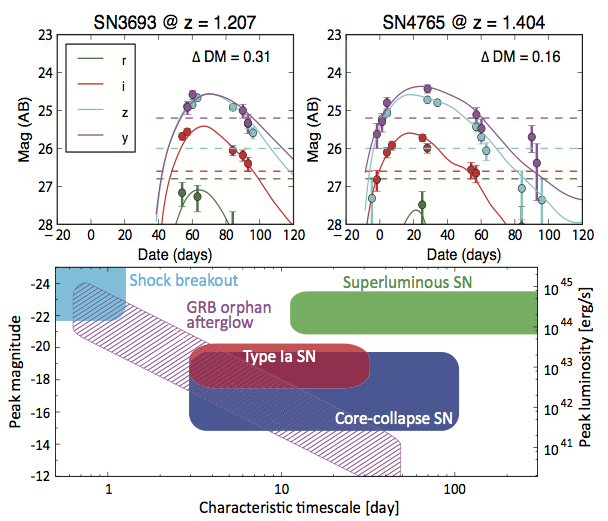Subaru/HSC has the widest field-of-view among instruments on the 8m-class telescopes. This unique capability enables us to explore the deep transient sky for the first time. By performing systematic cadence observations, we study various kinds of transients in the Universe.
In addition to Type Ia supernovae (SNe Ia) which are used as a cosmological probe, our survey will discover a number of extragalactic transients in various time scales; SN shock breakouts (z<3), core-collapse SNe (z<1), superluminous SNe (z<4), active galactic nuclei (z<6), and rare optical transients such as gamma-ray burst orphan afterglows and tidal disruption events. These data can be used to constrain the rate of SN explosions with cosmic time, the distribution of the time between star formation and SN explosions (which constrains models for the progenitors), correlations with host galaxy properties, cosmological evolution of supermassive black hole and so on.
Several kinds of observational cadence will be achieved within the SSP observation framework. Among the three survey layers, the Ultradeep layer data is optimal for exploring the deep transient sky. The observations in each broad-band filter for the Ultradeep layer are split over 20 epochs and light curves of SNe Ia at z=1.4 can be made with a good photometric accuracy.

[upper]: The expected sampling rate and photometric accuracy of light curves of SNe Ia at various redshifts. t=0 corresponds to the beginning of the 4 month period. The quantity Delta DM shown in each panel is the expected 1 sigma error of the distance modulus for the simulated SNe Ia, demonstrating that the sampling is adequate to measure the distances.
[lower]: Typical bolometric absolute magnitude of various transients in the HSC-SSP survey as a function of the characteristic timescale of variability.
